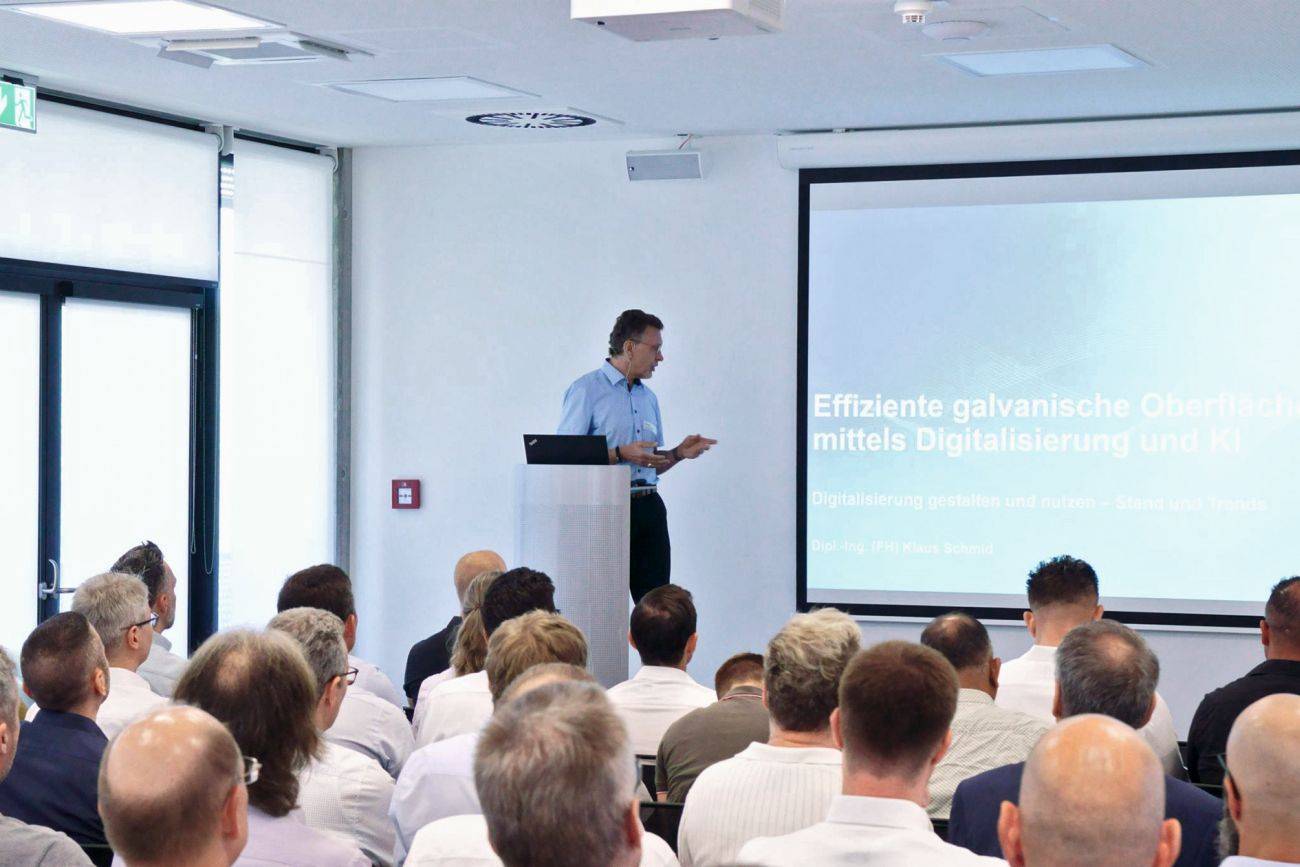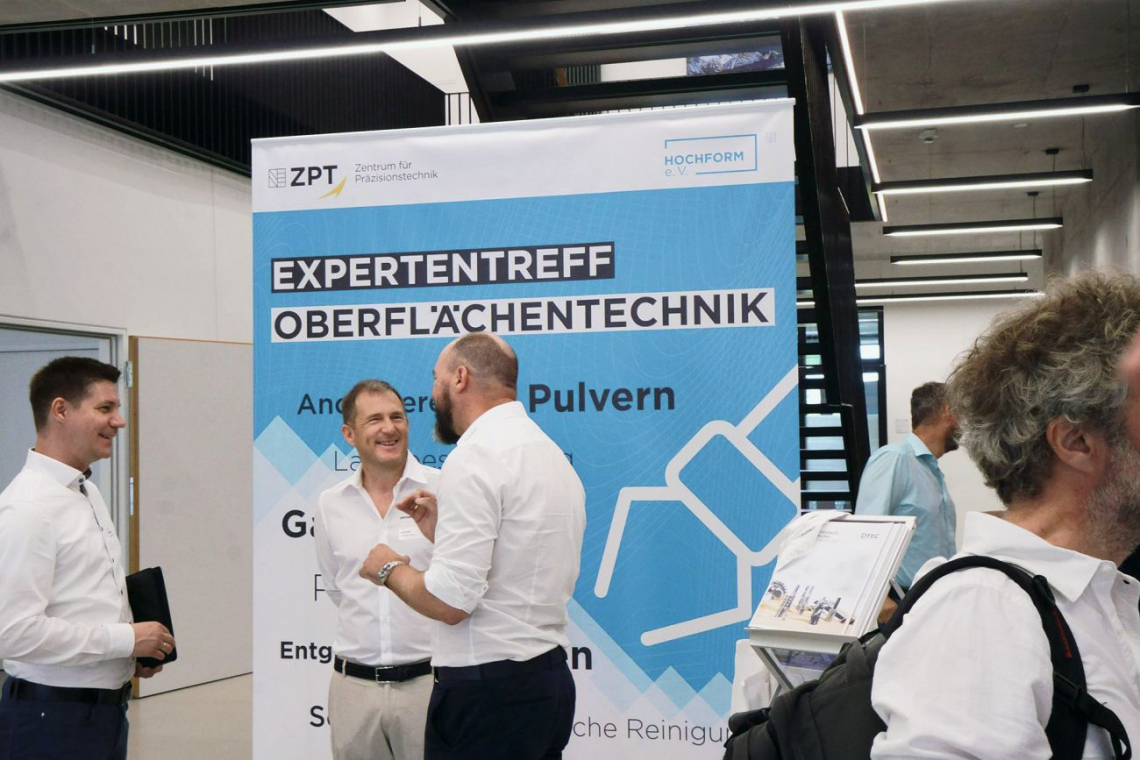At the end of June, the Surface 2025 expert meeting took place for the first time in Pforzheim at the ZFP Center for Precision Technology in the immediate vicinity of Pforzheim University. The event was organized by the Hochform network, which was formed in 2021 as a cluster initiative comprising 70 companies from the precision technology sector. The idea of the organizers was to bring together the extensive expertise in surface technology based in the southwest of the republic, to bundle it and to enter into a dialogue with the industry and interested parties.
The Fraunhofer Institute for Manufacturing Engineering and Automation (IPA) from Stuttgart and the companies IMO Oberflächentechnik GmbH, Wieland Edelmetalle GmbH, Dr. Ing.Max Schlötter GmbH & Co. KG, G.Rau GmbH & Co. KG, P3 - Plating Precision Pforzheim GmbH & Co. KG, OTEC Präzisionsfinish GmbH, Meusburger Georg GmbH & Co. KG, oelheld GmbH, Höckh Metall-Reinigungsanlagen GmbH, laserKRAFTwerk GmbH, ultraTec Innovation GmbH and RST GmbH were on site with presentations and/or their own stands.
The Expert Meeting Surface attracted a total of around 100 participants, who listened attentively and with interest to twelve high-caliber presentations. In these presentations, the topic of surfaces was examined in all its facets (scientific, technical, production organization, regulatory). The presentations were framed by a small but excellent accompanying company exhibition, in which companies presented their services and products and were able to make and deepen contacts with visitors to the event as well as maintain personal exchanges. After all, the surface technology sector is relatively small in Germany. People know each other - but not necessarily in person! There was something for every taste and almost every topic in surface technology.
The series of presentations was opened by a speaker from the Fraunhofer Institute for Manufacturing Engineering and Automation (IPA) on the topic of Industry 4.0 with digitalization and AI applications in surface and electroplating technology. Another subsequent presentation described the use of AI in component cleaning. However, the conclusion of both speakers was very sobering. German companies are rather cautious when it comes to the digitalization and application of AI and machine learning and still have a lot of catching up to do in order to fully exploit the potential of AI. Because it is important to remember: "Digitalization is here to stay."
Nitinol, a binary nickel-titanium alloy (50/50), a so-called intermetallic phase that is exceptionally non-brittle and is mainly used in the medical technology sector due to its properties that are predestined for medical applications, was the subject of a presentation. By influencing the surface oxide layer through chemical passivation, polishing or electropolishing, the properties, such as the migration rate of nickel, can be specifically influenced. This is why this type of layer is often used for stent technology, for example. The use of nickel-tin, silver-tin, bismuth and indium for coating components with press-fit zones was also discussed in a presentation. Despite the availability of these alternative modern coatings, pure tin is still most commonly used for such components.
 Twelve presentations, here by Klaus Schmidt from Fraunhofer IPA, were offered to around 100 participants
Twelve presentations, here by Klaus Schmidt from Fraunhofer IPA, were offered to around 100 participants
Visitors also found the marking of metallic surfaces using ultrashort laser pulses in the femtosecond to picosecond range to mark components for easier traceability and for design and advertising purposes interesting and innovative. This process can be used to apply durable, razor-sharp lettering etc., even in color or with a holographic effect. The material is removed by "pulverization" at the point where the lettering is to be applied. Even thermally sensitive surfaces can be easily labeled or marked.
The discussion of the actual coating methods such as dip, strip, brush, adhesive and spot technology in electroplating was not neglected either. Alternative coatings of silver-antimony, nickel-phosphorus with gold flash, nickel-phosphorus-silver instead of precious metals were also considered. PVD coatings (Physical Vapor Deposition) for the deposition of thin metal layers also have a potential in surface technology that should not be underestimated. This coating process is characterized by the fact that the layer thickness can be influenced and adjusted relatively easily. As no chemicals are used, this coating process can be regarded as extremely sustainable. However, the limiting factors of this coating method are the limited dimensions of the components to be coated and the so-called "flashlight effect". The latter refers to the phenomenon that with complex geometries and sharp-edged substrates, less coating is deposited in areas that are difficult to access due to the process. To mitigate this effect, it can be helpful to rotate the parts to be coated in the coating chamber.
The range of polishing processes presented (chemical, electrical, mechanical) was astonishing. As always, each of these processes has its own special properties, certain advantages and disadvantages that need to be considered if these methods are to be used. Furthermore, the development of a sensor for detecting the cleaning status of a component was reported on in detail, which can also detect certain contaminants that would not previously have been noticed when checking the cleaning result. State-of-the-art, intelligent, biodegradable liquid and solid high-performance lubricants and their applications were presented.
The appearance of a 23-year-old colleague, who was awarded first prize in the 2019 national "Jugend forscht" competition for his work on the simultaneous deburring and cleaning of complex and difficult-to-access components, such as bone screws and cannulas for the medical technology sector with the aid of an ultrasonic sonotrode, was exceptional. Almost two years later, he started his own business with his idea. His company, ultraTec Innovation GmbH from Laupheim, builds cleaning machines in various designs and configurations and is now part of a larger group of companies.
The final presentation dealt with the REACH regulation and used various examples to explain the difference between substances and mixtures on the one hand and articles on the other, the associated different requirements and obligations of manufacturers, importers, distributors and users in connection with registration and passing on information on SVHC to customers and authorities, as well as the pitfalls that need to be taken into account.
Due to the positive response, the expert meeting will be repeated in two years at the latest. The event culminated in a sumptuous barbecue accompanied by live jazz music in midsummer temperatures. What was also remarkable about this expert meeting was that participation in this event was free of charge for participants, except for travel and any accommodation required. The event was sponsored by a number of companies, including IMO Oberflächentechnik, Wieland, Oelheld, RST Oberflächentechnik, Höckh Parts Cleaning, KF Industrieanlagen and ZPT Zentrum für Präzisionstechnik.


